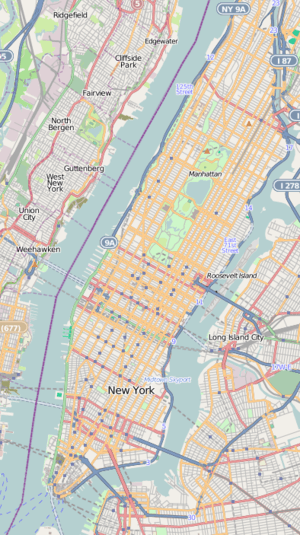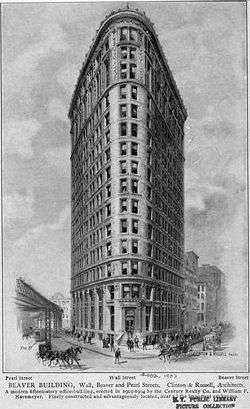1 Wall Street Court
| 1 Wall Street Court | |
|---|---|
|
Looking west at Beaver Building | |
 1 Wall Street Court | |
| Former names |
|
| General information | |
| Status | Complete |
| Type | Skyscraper |
| Architectural style | Renaissance |
| Classification | Condominiums |
| Location | Financial District (Manhattan) |
| Address | 82-92 Beaver Street at Pearl Street |
| Town or city | New York City |
| Country | United States |
| Coordinates | 40°42′19.08″N 74°0′30.096″W / 40.7053000°N 74.00836000°W |
| Construction started | June 1903 |
| Completed | October 1904 |
| Renovated | 2006 |
| Cost | $600,000 (1904) equivalent to $15,802,222 in 2016 |
| Height | |
| Roof | 205 feet (62 m) |
| Technical details | |
| Floor count | 15 |
| Lifts/elevators | 4 |
| Design and construction | |
| Architecture firm | Clinton & Russell |
| Known for | Former headquarters of the New York Cocoa Exchange |
|
Beaver Building | |
 | |
|
Engraving of the Beaver Building published in 1905 | |
| Location | New York City, New York |
| Built | 1904 |
| Architect | Clinton & Russell |
| Architectural style | Renaissance |
| NRHP Reference # | 05000668[1] |
| NYCL # | LP-1942[2] |
| Significant dates | |
| Added to NRHP | July 6, 2005 |
| Designated NYCL | February 13, 1996 |
1 Wall Street Court in the Financial District of Manhattan, also known as The Beaver Building and The Cocoa Exchange (as the former home of the New York Cocoa Exchange)[3] is a triangular-shaped building reminiscent of the Flatiron Building. The building, designed by Clinton and Russell and completed in 1904, is located at the intersection of Wall Street, Pearl Street, and Beaver Street.
History
The 15-story Beaver Building, designed in the neo-Renaissance style by the well-known and prolific firm of Clinton & Russell and built from 1903–04, was commissioned by the Century Realty Co. as a speculative office building. The steel-framed, flatiron shaped structure occupies a narrow quadrilateral lot at the juncture of Beaver and Pearl Streets near Wall Street. The design has the tripartite arrangement of base-shaft-capital common to many of New York's early skyscrapers, with a stone base, a midsection faced in brick laid in bands of tan and buff shades, and a top section richly ornamented with glazed terracotta in shades of green, cream, and russet, incorporating both classically-derived and abstract geometric motifs.[2]
The Beaver Building is a notable example of the design solution for turn-of-the-century New York skyscrapers in which each section of the tripartite scheme is differentiated by color and materials. It is also a very early example of the use of boldly polychromatic glazed terracotta, as well as a significant survivor of this period of terracotta development. Carved ornament depicting beavers, representing the name of the building, is found over the Beaver Street entrance and below the primary cornice of the base.[2]
The building was the headquarters from 1904 until 1921 of the Munson Steamship Company, an American steamship shipping line active in the Cuban and South American sugar and lumber trade; the company owned the building from 1919 to 1937. From 1931 to 1972, one of the building's primary tenants was the New York Cocoa Exchange, the world's first and foremost cocoa futures market, amidst the United States' emergence as the world's largest cocoa consumer. Despite some alterations in the 1980s, the Beaver Building remains a notable example of a medium-height, turn-of-the-century skyscraper on the narrow streets of lower Manhattan.[4] Original plans called for a bank to occupy the double height first story and mezzanine space and for a restaurant to be located in the basement. The narrow quadrilateral site of the building, at the juncture of Beaver and Pearl Streets near Wall Street, is created by the original colonial street pattern of Lower Manhattan.[2][5]
Munson Steamship Company
The Beaver Building was occupied, in part, as headquarters of the Munson Steamship Co. from May 1904 until 1921, and was sometimes known as the "Munson Beaver Building." Munson was a prominent steamship line that handled cargo between the United States and Cuba, as well as the eastern coast of South America. Walter D. Munson had emigrated to Havana in 1868 to enter the sugar and molasses business, began to charter ships by 1873 to transport sugar to the United States, and moved his offices to New York City in 1882. After he acquired a fleet of steamships, and after the Spanish–American War fully opened Cuba to American commerce, Munson incorporated his company in 1899, hauling sugar along the New York-Mobile-Cuba route. With Walter Munson's death, the company was directed by his sons Carlos and Frank, who added South American lumber to the business in 1910.[2]
Amidst the large profits accumulated by American shipping companies during World War I, and "owing to the scarcity of office accommodations in the vicinity" according to the New York Times, the Munson Steamship Co. purchased the Beaver Building in July 1919. The company constructed a new 25-story office tower across Beaver Street at 67-71 Wall Street (completed in May 1921 to the design of Kenneth M. Murchison) that represented the second largest investment in new construction by a shipping concern during this period, after that of the Cunard firm. Munson Building Corp. retained ownership of the Beaver Building until foreclosure by the Bowery Savings Bank in 1937. During the 1920s, the company suffered a decrease in its Cuban sugar trade due to increased competition, and neither the inclusion of South American passenger service in 1920, nor mail service in 1928, proved profitable enough to offset the losses. After a failed attempt to sell the line to the International Mercantile Marine Co., the company came under bankruptcy protection in 1934 and was finally dissolved in 1939.[2][6]
New York Cocoa Exchange
For the next forty years, from 1939 until 1979, the New York Cocoa Exchange was one of the primary tenants in the Beaver Building, with the trading room on the first story and mezzanine. The Cocoa Exchange was established in New York in 1925 (at 124 Water Street),[7](subscription required) by cocoa users seeking to eliminate risk due to price fluctuations, as the world's first cocoa futures market. As the production and consumption of cocoa and chocolate products expanded rapidly in the twentieth century and cocoa developed as a leading international commodity, the United States emerged as the world's largest cocoa consumer. When the Cocoa Exchange moved into the Beaver Building in April 1931, the New York Times noted that "the Exchange has grown to be the largest market of its kind in the world, and transactions on its floor usually equal and frequently have exceeded the world's crop of cocoa." Many of the other commodities exchanges were also located in the immediate vicinity of Beaver and Broad Streets at this time. The Beaver Building additionally housed a number of commercial tenants and organizations associated with the cocoa industry over the years, including the New York Cocoa Clearing Association and Cocoa Merchants Association of America. The Cocoa Exchange moved from the Beaver Building to new quarters (127 John Street) in 1972; it merged with the New York Coffee & Sugar Exchange to form the Coffee, Sugar & Cocoa Exchange in 1979.[8]
Building today
After Bowery Savings Bank disposed of the property in 1942, the Beaver Building changed hands several times; 82 Beaver Co. (with Harry B. Helmsley as a partner) owned the building from 1951 to 1981. In 1985, London & Leeds Realty Corp., a British-based development company, began a renovation of the nearly vacant Beaver Building, at the same time as its construction across Pearl Street of the Barclays Bank Building at 75 Wall Street. This renovation resulted in some minor modifications of the Beaver Building's exterior, as well as the creation of a new address, 1 Wall Street Court. Since 1994, the building has been owned by Cocoa Partners. In 2006, the building underwent conversion to become a residential condominiums.[9]
Popular culture
The building was used as the setting for the exterior shots of the Continental Hotel in the film John Wick.[10]
References
- ↑ "Beaver Building NYC" (PDF). National Park Service. Department of the Interior. Retrieved 20 June 2015.
- 1 2 3 4 5 6 "BEAVER BUILDING" (PDF). Landmarks Preservation Commission. City of New York. Retrieved 20 June 2015.
- ↑ "Cocoa Exchange renews its lease". The New York Times. January 22, 1964. Retrieved July 10, 2014.
- ↑ Horsley, Carter. "Info & Ratings - Cocoa Exchange Review". CityRealty.com. Retrieved July 11, 2014.
- ↑ "NEW YORK’S "SLIPS," Financial District, Lower East Side". Forgotten New York. 27 January 2013. Retrieved 20 June 2015.
- ↑ Blume, Kenneth J. (2012). Historical Dictionary of the U.S. Maritime Industry. Lanham: Scarecrow Press. p. 342. ISBN 9780810879638. Retrieved 20 June 2015.
- ↑ "(New York Cocoa Exchange, Inc.)". The Brooklyn Daily Eagle (Brooklyn, New York: newspaper.com). Brooklyn Public Library. 24 June 1928. Retrieved 20 June 2015.
- ↑ "Coffee, Sugar, and Cocoa Exchange (CSCE)". Investorguide.com. Retrieved 20 June 2015.
- ↑ "Development Du Jour: The Cocoa Exchange". Curbed. 2006-04-19. Retrieved 2010-06-30.
- ↑ "The Continental Hotel in John Wick". Legendary Trips. 2014-11-21. Retrieved 2015-05-05.
External links
| Wikimedia Commons has media related to 1 Wall Street Court. |
- New York City Landmarks Preservation Commission report on the Beaver Building
- Emporis: Cocoa Exchange
| |||||||||||||||||||||||||


